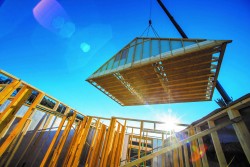The dust has now settled following the launch of the Housing White Paper when Sajid Javid, Secretary of State for Communities and Local Government, outlined what he called 'the bold radical vision for the housing market'. As the industry devours and disseminates the content, many construction commentators have come to the conclusion that there are no new exciting ideas or big surprises but a change of direction can be extracted with some careful sifting.
One of the key themes to emerge is the government's commitment to support offsite factory built homes. This document came 'hot on the heels' of the Farmer Report where the author Mark Farmer, called for the industry to 'Modernise or Die'. So, the scene is set and the key 'offsite' players are lining up to take centre stage.
Here at the Structural Timber Association, we firmly believe that offsite timber construction is the only way to reach the specified target of one million homes by 2020. With four out of five new homes in Scotland being built from structural timber - we know that offsite timber solutions address many government concerns associated with public procurement of housing including speed of build, environmental impact, lifetime energy efficiency and cost performance. These factors are all largely beneficial not only to government plans but to the wider community. Structural timber solutions outweigh other sectors in regards to volume of materials - the sector is quick to respond and can add capacity at a relatively rapid rate to meet demand. Shortages in other traditional construction materials will continue to encourage larger builders and specifiers to look to alternatives.
Innovation in the structural timber product range has broadened the appeal - the industry is no longer defined simply by the supply of timber frame kits and panelised solutions. It is driven by intelligent and integrated construction solutions, such as closed panel timber frame, structural insulated panel systems and volumetric modular options.
As the government pledge support for small and medium size developers, as well as initiatives for self and custom builders - in theory there is a lot of positive content in this White Paper. Making the planning system more accessible and releasing land that is currently in public sector ownership, will certainly have an impact but only time will tell how it works in practise.
We're geared up and ready to go - the time is right for the construction industry to embrace innovative timber technology and offsite techniques to develop better buildings at a rapid rate to meet government targets, to overcome the shortfall in housing stock and produce energy efficient buildings.
Author Andrew Carpenter, Chief Executive of the Structural Timber Association









